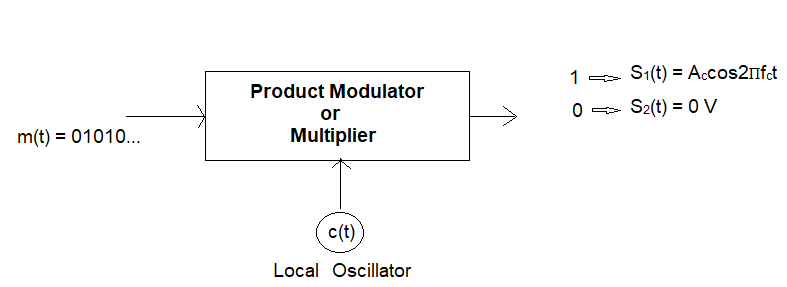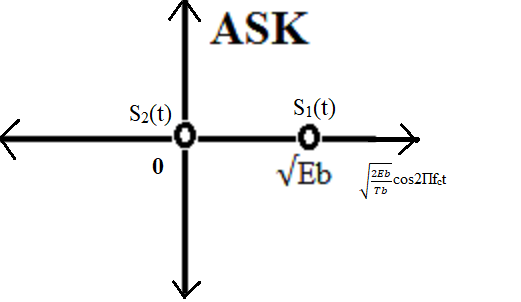Amplitude shift keying, Frequency Shift Keying, Binary Phase Shift Keying: Generation and Detection
Amplitude Shift Keying (ASK)
Theory:
Amplitude Shift Keying (ASK) is one of the simplest digital modulation techniques. In this method, a single carrier wave is switched ON or OFF to transmit binary symbols. The binary ASK system was an early form of digital modulation, used in wireless telegraphy. In a binary ASK system, binary symbol '1' is represented by transmitting a sinusoidal carrier wave of fixed amplitude Ac and fixed frequency fc for the bit duration Tb. Binary symbol '0' is represented by switching off the carrier for Tb seconds. This signal can be generated simply by turning a sinusoidal oscillator's carrier ON and OFF according to the modulating pulse train, which is why this scheme is also known as On-Off Keying (OOK). The ASK signal can be generated by applying the incoming binary data and the sinusoidal carrier to the two inputs of a product modulator. The resulting output is the ASK wave.
In this modulation, binary '1' is represented by the presence of a carrier and binary '0' by the absence of a carrier.
ASK Transmitter:

Here, the electrical signal representation technique is ON-OFF coding.
In which
1 => +V (positive voltage)
0 => 0 V (zero voltage)
ASK Receiver:
For the demodulation of ASK, a coherent detector is typically used. This involves correlating the received signal with the carrier wave.
- For binary '1' (carrier present): The output of the correlator (or matched filter) will be proportional to the amplitude of the received carrier, e.g., Ac * Tb / 2.
- For binary '0' (carrier absent): The output will be close to zero.
A threshold detector then compares this output to a predetermined threshold to decide whether a '1' or '0' was transmitted.

The receiver aims to differentiate between the presence and absence of the carrier to recover the original binary data.
Constellation Diagram of ASK

Figure: Constellation Diagram of Binary ASK
In the above figure, the reference axis corresponds to the normalized
basis function φ1(t) = √(2/Tb) cos(2Пfct) for 0
≤ t ≤ Tb.
Distance of the '1' symbol from the origin is √(Eb). Energy
of the '1' symbol = {√(Eb)}2 = Eb.
Distance of the '0' symbol from the origin is 0. Energy of the '0'
symbol = 0
Distance between signaling points, d12 = √(Eb).
High-order Amplitude Shift Keying (ASK) refers to using a large number
of amplitude levels to represent digital data. For instance, in binary
ASK (BASK), there are two amplitude levels, usually represented as 0 and
1. High-order ASK can have more than two amplitude levels, such as 4,
8, 16, 64, etc.
Under different noise configurations
Let's explore ASK modulation under two common noise scenarios: AWGN (Additive White Gaussian Noise) and Rayleigh fading.
ASK Modulation with AWGN:
We've already discussed the effect of AWGN on ASK modulation in the
previous response. The mathematical effect involves adding
Gaussian-distributed noise to the modulated signal. The received signal
y(t) is given by:
y(t) = x(t) + n(t)
Where:
x(t) is the modulated ASK signal.
n(t) is the AWGN.
The effect of AWGN is to add random variations to the amplitude of the
signal, which can lead to erroneous detection of the transmitted
symbols. The SNR (signal-to-noise ratio) plays a crucial role in
determining the quality of demodulation, with higher SNR values leading
to better performance.
ASK Modulation with Rayleigh Fading:
Rayleigh fading is a type of multipath fading that occurs in wireless
communication channels. It's characterized by a random variation in the
amplitude of the received signal due to constructive and destructive
interference of multiple signal paths.
Mathematically, Rayleigh fading can be represented as a complex Gaussian
random variable with zero mean and a certain variance. The received
signal y(t) in the presence of Rayleigh fading can be represented as:
y(t) = h . x(t) + n(t)
Where:
h is the complex fading coefficient, representing the channel gain and
phase shift.
x(t) is the modulated ASK signal.
n(t) is the noise
The fading coefficient h introduces random amplitude and phase
variations to the signal. Due to the randomness of h, the received
signal's amplitude will experience fluctuations, impacting the detection
of transmitted symbols. The actual fading distribution might vary
depending on the specific channel characteristics.
When ASK modulation is subjected to different noise configurations, the
mathematical representation of the received signal changes. Under AWGN,
Gaussian noise is added to the signal's amplitude. Under Rayleigh
fading, the complex fading coefficient introduces random amplitude and
phase variations. The performance of ASK modulation in these scenarios
depends on the SNR for AWGN and the characteristics of the fading
channel for Rayleigh fading.
